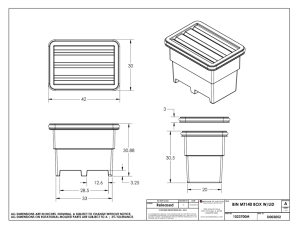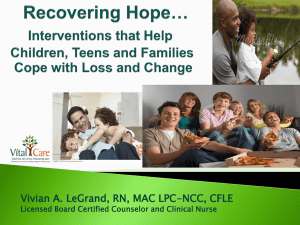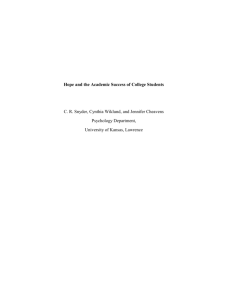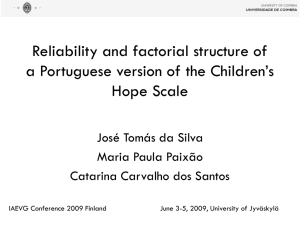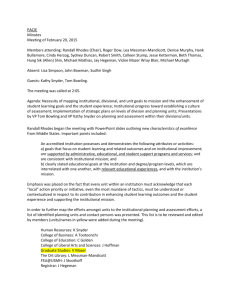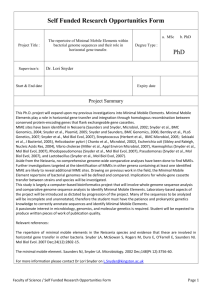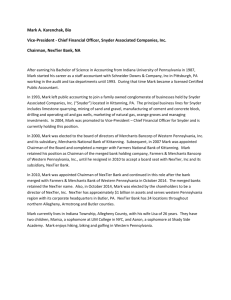Hope Interventions - Orientation & First
advertisement
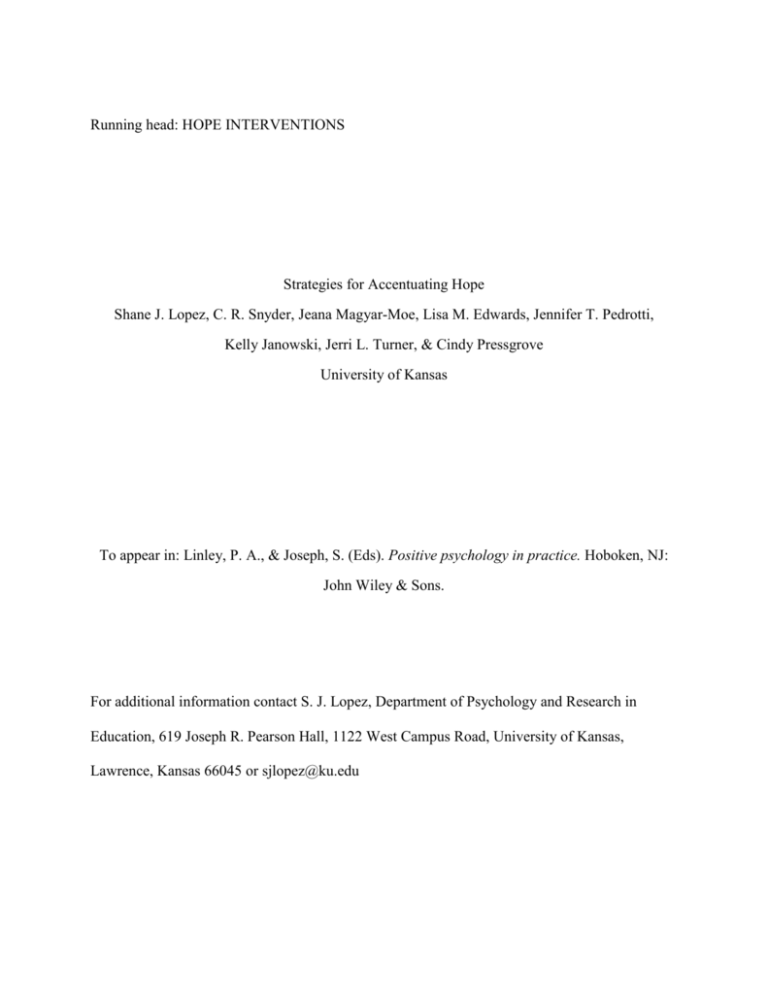
Running head: HOPE INTERVENTIONS Strategies for Accentuating Hope Shane J. Lopez, C. R. Snyder, Jeana Magyar-Moe, Lisa M. Edwards, Jennifer T. Pedrotti, Kelly Janowski, Jerri L. Turner, & Cindy Pressgrove University of Kansas To appear in: Linley, P. A., & Joseph, S. (Eds). Positive psychology in practice. Hoboken, NJ: John Wiley & Sons. For additional information contact S. J. Lopez, Department of Psychology and Research in Education, 619 Joseph R. Pearson Hall, 1122 West Campus Road, University of Kansas, Lawrence, Kansas 66045 or sjlopez@ku.edu Hope Interventions 2 Introduction People somehow summon enough mental energy to set the goal of seeking a therapist or other healer. Likewise, they identify pathways to the desired helper and muster the requisite energy to build a working alliance with their newfound agent of change. In essence, self-referred clients demonstrate hope in their pursuit of therapeutic support by the time that they reach their therapist. In turn, therapists can help clients to name and to nurture the hope that they already possess. In this chapter, we identify formal strategies for accentuating the hope that people possess. Where available, we discuss the effectiveness data associated with these strategies. Given that most therapists are eclectic, we also describe informal strategies that could be implemented within any therapeutic framework; moreover we will address common strategies that can be assigned to clients as "homework." We will begin by outlining hope theory and discuss hope's role as an active ingredient in psychological change. Hope Theory According to hope theory, hope reflects individuals’ perceptions regarding their capacities to: (1) clearly conceptualize goals; (2) develop the specific strategies to reach those goals (pathways thinking); and (3) initiate and sustain the motivation for using those strategies (agency thinking). The pathways and agency components are both necessary, but neither by itself is sufficient to sustain successful goal pursuit. As such, pathways and agency thoughts are additive, reciprocal, and positively related, but they are not synonymous (Snyder, 1989, 1994, 2000a, 2000b, 2002; Snyder, Harris et al., 1991). According to hope theory, a goal can be Hope Interventions 3 anything that an individual desires to experience, create, get, do, or become. As such, a goal may be a significant, lifelong pursuit (e.g., developing a comprehensive theory of human motivation), or it may be mundane and brief (e.g., getting a ride to school). Goals also may vary in terms of having perceived probabilities of attainment that vary from very low to very high. On this point, it should be noted that high-hope individuals prefer “stretch goals” that are slightly more difficult than previously attained goals. Whereas other positive psychology constructs such as goal theory (Covington, 2000; see also Dweck, 1999), optimism (Scheier & Carver, 1985), self-efficacy (Bandura, 1982), and problem-solving (Heppner & Petersen, 1982) give differentially weighted emphases to the goal itself or to the future-oriented agency- or pathways-related processes, hope theory equally emphasizes all of these goal-pursuit components (Snyder, 1994). For detailed comparisons of the similarities and differences between hope theory and other theories (e.g., achievement motivation, flow, goal setting, mindfulness, optimism, optimistic explanatory style, problemsolving, resiliency, self-efficacy, self-esteem, Type A behavior pattern, etc.), see Magaletta and Oliver (1999), Peterson (2000), Snyder, (1994, 2002), and Snyder, Rand, and Sigmon (2002). Hope as an Agent of Change The power of hope as a motivating force has been discussed throughout modern time and, for the past century, has been examined by medical and psychological scholars. Over the last 40 years, Jerome Frank's (1968, 1975) work has conceptualized hope as a process that is common to all psychotherapy approaches. Karl Menninger (1959), as the president of the American Psychiatric Association, in his academic lecture on hope, issued a call for more rigorous examination of the role of hope in change. As in a response to Menninger’s request, Snyder's Hope Interventions 4 operationalization of this robust construct has facilitated, over he last two decades, the scholarly inquiry into hope as a change agent. Indeed, whatever the system of psychotherapy, beneficial change may be attributable, in part, to hope. According to Snyder, Rand, and Sigmon (2000), change occurs because people learn more effective agentic and pathways and goal-directed thinking. In particular, the agency component is reflected in the placebo effect (i.e., the natural mental energies for change that clients bring to psychotherapy). The particular psychotherapy approaches that are used to provide the client with a route or process for moving forward to attain positive therapeutic goals reflect the pathways component. (p. 267) Furthermore, Snyder and his colleagues (Snyder, Ilardi, Cheavens, et al., 2000; Snyder, Ilardi, Michael, & Cheavens, 2000) have offered detailed hypotheses about how hope, and agency and pathways in particular, might help to explain the role of common and specific treatment factors in psychotherapy. Before any specific treatment strategies are applied, the primary source of change is the client's expectancy that therapy will make a positive difference in his or her life. These initial improvements are analogous to increases in the agency component of hope-determination that one can make improvements in their life. Therefore, it is believed that increases in agency, as opposed to increases in pathways thinking, will be related to positive change in the first stages of therapy. The positive changes that occur in these early stages of therapy have been described elsewhere as "remoralization" (Howard, Krause, Saunders, & Koptka, 1997), and they are characterized by enhanced subjective well-being. More specifically, clients begin to experience relief from distress, and have renewed hope that their situation can Hope Interventions 5 and will improve. Increased well-being even may take place before the client steps into therapy room; that is to say, an initial phone call to set up the appointment may engender feelings of relief from distress. From this perspective on hope, it is conceivable that hope is malleable and that it can be the spark for and pathway to change. Likewise, beneficial change may lead to more hope for creating a good life. Because most people have the capacity to hope (they possess the basic components of the cognitive skills needed to generate a hopeful line of thought), accentuating this change agent requires naming and nurturing this personal strength in the context of supportive helping relationships. We propose that hope finding, bonding, enhancing, and reminding are the essential strategies for accentuating hope. Hope finding can strengthen the clients’ expectations that the therapists can and will help them. Bolstering the clients’ expectations for assistance simultaneously may instill hope in change and enhance the therapeutic bond between client and therapist. Hope bonding is the formation of a sound hopeful therapeutic alliance; it grounds the client in a hopeful therapeutic context. Therapists possessing high levels of hope may be most facile at meeting the important therapeutic goal of establishing an emotionally charged connection. They also may be best at collaborating on mutually agreed upon goals by engaging in productive tasks. Hope enhancing strategies typically involve enlisting clients in tasks that are designed to: (1) conceptualize reasonable goals more clearly; (2) produce numerous pathways to attainment; (3) summon the energy to maintain pursuit; and (4) reframe insurmountable obstacles as challenges to be overcome. Hope reminding is the promotion of effortful daily use of hopeful cognitions. Goal thoughts and barrier thoughts are identified cognitive cues that stimulate the Hope Interventions 6 client to incorporate therapeutic techniques that have previously enhanced hopeful thought. Next, we will describe the formal and informal strategies for accentuating hope by finding, bonding, enhancing, and reminding. Hope Finding Hope can exist as a relatively stable personality disposition (i.e., a trait), or as a more temporary frame of mind (i.e., a state). Similarly, hopeful thought can occur at various levels of abstraction. For example, one can be hopeful about achieving: (1) goals in general (i.e., a trait); (2) goals in a certain life arena (i.e., domain-specific); or (3) one goal in particular (i.e., goalspecific). Finding the hope that each person possesses is essential to building personal resources in preparation for the therapeutic change process. Naming and measuring the type of hope most relevant to a client's goal pursuit can be achieve via formal and informal means. Formal Strategies Brief, valid measures of hope can be used during initial phases of therapy to find an individual's hope. Snyder, Hoza et al. (1997) developed the Children’s Hope Scale (CHS) as a trait hope measure for children ages seven through 14 years (see Appendix A). The CHS is comprised of three agency and three pathways items, and it has demonstrated satisfactory psychometric properties: (1) internal consistencies (overall alphas from .72 to .86); (2) test-retest reliabilities of .71 to .73 over one month; and (3) convergent and discriminant validities. Furthermore, this scale has been used with physically and psychologically healthy children from public schools, boys diagnosed with attention-deficit/hyperactivity disorder, children with various medical problems, children under treatment for cancer or asthma, child burn victims, Hope Interventions 7 adolescents with sickle-cell disease, and early adolescents exposed to violence (Snyder, Hoza et al., 1997). To measure the trait aspect of hope in adolescents and adults, ages 15 and higher, Snyder, Harris et al. (1991) developed the Hope Scale (see Appendix A). This scale consists of four items measuring agency, four items measuring pathways, and four distracter items. Having been used with a wide range of samples, the Hope Scale has exhibited acceptable reliability and validity: (1) internal consistency (overall alphas from .74 to .88; agency alphas of .70 to .84; and pathways alphas of .63 to .86); (2) test-retest reliabilities ranging from .85 for three weeks to .82 for ten weeks; and (3) concurrent and discriminant validity (Snyder, Harris et al., 1991). (Lopez, Ciarlelli, Coffman, Stone, and Wyatt, 2000, provide an in-depth coverage of these formal measures, including the development and validation of additional self-report, observational, and narrative measures of hope.) Informal Strategies Narrative approaches often have been used to illustrate the theory of hope to children, adolescents, and adults in individual therapy and psychoeducational programs. By telling stories of fictitious and real characters, therapists engage clients in thinking about goals, agency, and pathways. Furthermore, with time, clients tell stories about their goal pursuits, thereby making hope more personally relevant. Hope-related themes are captured when clinicians explore the following aspects of clients' stories: 1. 2. 3. 4. 5. How did the client generate goals? What was the motivation? How attainable or realistic were the goals? How were the goals perceived? What was the client’s mood/attitude during the process? Hope Interventions 8 6. How was movement toward goals initiated? 7. How was movement maintained? 8. What were the biggest barriers to reaching the goals? 9. What emotions did these barriers elicit? 10. How were barriers overcome and what steps were taken to reach the goals? 11. Were the goals attained? 12. How does client feel about the outcome? 13. If the client were to attempt same goal today, what would he/she do differently? 14. Can the client re-cast the experience in more hopeful terms? (i.e., by identifying lessons learned that can facilitate future efforts.) It may be necessary to offer some suggestions so as to direct the client’s attention to hopeful elements in their stories. It should be emphasized that these narratives should support a sense of movement rather than stagnant rumination. The benefits of narrative techniques come from the integrating of these cognitive and emotional elements of the client’s stories. Another informal strategy, hope profiling is a semi-structured intervention in which the therapist requests that the client writes (or audiotapes) brief stories about past and current goal pursuits in order to uncover the hope that is part of a person's psychological make-up. Typically five stories (two to five pages in length) detailing goal pursuits in various life domains reveal the requisite pathways and agency involved in hopeful pursuits. Review of these stories in the therapeutic context can help clients to realize that they have the resources necessary to make positive changes. Also, clients learn the language of hope by identifying the goal thoughts, pathway thinking, and agency sources referred to in their narrative. Hope Bonding Bordin (1976) defined the working alliance as the collaboration between the therapist and client that is based on their agreement on the goals and tasks of counseling and on the development of a personal attachment bond. As described previously, Snyder’s (1994) Hope Interventions 9 conceptualization of hope suggests a model comprised of three cognitive components: goals, agency, and pathways. Goals are considered the targets or endpoints of mental action sequences and, as such, form the anchor of hope theory (Snyder, Ilardi, Michael, & Cheavens, 2000). Pathways, which are the routes toward desired goals, are necessary to attain goals and navigate around obstacles. Finally, agency taps the motivation that is necessary to begin and sustain movement towards goals. Given these definitions, it seems plausible that working alliance goals coincide with hope goal thoughts, tasks coincide with pathways, and the bond translates to agency (Lopez et al., 2000). Indeed, empirical research has supported this theoretical relationship between the working alliance and hope and their components (i.e., tasks and pathways, bond and agency; Magyar-Moe, Edwards, and Lopez, 2001). Although one cannot determine the causality through correlational data, the large amount of shared variance (r=.48) between these two models suggests that increasing an individual’s levels of hope also may increase working alliance ratings and vice versa. Thus, working to build hopeful alliances seems appropriate, given the many positive correlations between the working alliance, hope, and various positive outcomes (Horvath & Greenberg, 1994; Snyder, 2000). Formal Strategies Working alliance and hope researchers have outlined what it takes to form a productive therapeutic relationship, and have described how a sound relationship is associated with beneficial change. Indeed, Bordin (1994) stated that negotiation between the client and therapist about the change goal that is most relevant to the client’s struggle is essential. Such negotiation depends largely upon the bonding component, defined as the positive personal attachment between the client and the therapist that results from working together on a shared activity. Hope Interventions 10 Bonding in therapy usually is expressed in terms of liking, trusting, and respect for one another, in addition to a feeling of mutual commitment and understanding in the activity (Bordin, 1994). Such a relationship mirrors that required for begetting hope. According to Snyder and colleagues (1997), hope flourishes when people develop a strong bond to one or more caregivers, allowing the person to perceive himself or herself as having some sense of control in the world. “As social creatures, we need to confide in someone about our dreams and goals” (Rodriguez-Hanley & Snyder, 2000, p. 46). Thus, it seems that for both the therapeutic alliance and for hope to develop, a supportive environment is needed in which people receive basic instruction in goal pursuits from a positive model (Snyder, 2000). Building the working alliance based on hope theory principles seems in order, given that the goal of connecting with other people is fundamental, that the seeking of one’s goals almost always occurs within the context of social commerce (Snyder, Rand, & Sigmon, 2002), and that goal directed thinking virtually always develops in the context of other people who teach hope (Snyder, 2000). Indeed, Lopez and colleagues (2000) state that hope enhancement strategies “are designed to help clients in conceptualizing clearer goals, producing numerous pathways to attainment, summoning the mental energy to maintain the goal pursuit, and reframing insurmountable obstacles as challenges to be overcome. The hopeful therapeutic relationship facilitates these hope components” (p. 123). Taken together, the working alliance and hope literature suggests that building a hopeful alliance involves: (1) respectfully negotiating flexible therapeutic goals: (2) generating numerous and varied pathways to goal attainment: and (3) translating the sense of connectedness between therapist and client into the mental energy necessary to sustain pursuit toward therapeutic goals. Hope Interventions 11 Informal Strategies Based on the assumption that hope begets more hope, hopeful familial relationships and friendships could serve as hope-enhancing agents. Clients could benefit from evaluating their relationships and determining which generate mental energy that facilitates coping, and those that drain that energy. Though data about hope in friendships, sibships, and marriages have not been collected, the infectious nature of hope in such contexts has been assumed (Snyder, 1994). Therefore, therapists should encourage the development of new relationships that increases hope in one’s life. Associating with individuals who are supportive of goal pursuits, who challenge their peers to pursue “stretch” goals, and who encourage peers to overcome barriers may help people crystallize their hopeful thought. Hope Enhancing All individuals inherently possess hope (Snyder, Harris et al., 1991; Snyder, Hoza et al., 1997). Nevertheless, there is variability in terms of the level of hope that one individual might possess as compared to a peer. It has been shown through previous research that children, adolescents, and adults with higher levels of hope do better in school and athletics, have better health, better problem-solving skills, and are more adjusted psychologically (Snyder, 2002; Snyder, Cheavens, & Michael, 1999). As such, enhancing hope may have much benefit for these individuals. As people chart their own paths through life, a sense of hope can assist them in making good decisions about their goals. Formal Strategies One of the first interventions aimed at increasing hope in children was developed by McDermott, Gariglietti, Hastings, Gingerich, and Callahan (1996). This program involved eight Hope Interventions 12 weekly sessions with first through sixth grade students at a culturally diverse elementary school. During each week of this program, students were presented with information about hope and goal-setting, as well as stories about high-hope children. Through hearing and discussing these stories each week for 30 minutes, children had the opportunity to identify goals in the lives of protagonists, as well as to apply the hope concepts to their own lives. Evaluation of the program was conducted through comparing pre and post-test hope scores for the intervention group to a control group of students, and results demonstrated that there were modest gains. Furthermore, teacher ratings of students' levels of hope were significantly higher at post-test, suggesting that they perceived increases in their students' levels of hopeful thinking. McDermott et al. concluded that an 8-week session was not sufficient time to instill high hope, but they considered their results as promising (McDermott & Hastings, 2000). Another elementary school intervention, Making Hope Happen for Kids (Edwards & Lopez, 2000), was developed to enhance hope in fourth grade students. This five session program, based on the general format of the junior high school program (described subsequently), involves age-appropriate activities and lessons related to learning about hope and applying this construct to children's lives. During this five-session program, which was conducted in several classrooms, two graduate student co-facilitators led groups of 7-10 students in various activities and lessons. The first week of the program involved learning about the hope model and acting out the parts of the model with laminated props. Students pretended to be goals, obstacles, pathways, and willpower (i.e., agency) in a brief psychodrama depicting meaningful goal pursuits. In the second week, children were introduced to a story that described a young girl navigating obstacles Hope Interventions 13 as she worked toward the goal of learning lines for her school play. The third week of the program involved the Hope Game (a board game depicting multiple goal pursuits), during which children identified obstacles, pathways and agency thoughts as they worked in teams to accomplish a shared goal. During the fourth week, children designed hope cartoons, emphasizing hopeful language. Finally, during the last week of the program, children were asked to write hope stories describing the goals on which they had been working, and then shared their stories with one another; they then enjoyed snacks to celebrate the end of the program. Evaluation of the program was conducted at the end of the first and second years. The Children's Hope Scale (Snyder, Hoza, et al., 1997) was administered before and after delivery of the intervention with all children. While the evaluation of this program did not include a control group, comparisons of means at pre- and post-test demonstrated significant gains in hope scores in the fourth grade students. Thus, hope was enhanced in these young children. Pedrotti, Lopez, and Krieshok (2000) developed a program for seventh graders designed to enhance hope through five weekly 45-minute sessions. Assistance from classroom teachers allowed this version of the Making Hope Happen program to be integrated into the regular school day as a part of a family consumer sciences course. Groups consisting of eight to twelve students were formed, and each was facilitated by two graduate student leaders. The program was designed to enhance the hope inherent in these youth by teaching them about the hope model. The five sessions were developed to take these adolescents through the hope model step by step. During the first session, students were taught about the hope model in general, through the use of posters and cartoons. Pictorial representations were used to exemplify the different Hope Interventions 14 components to help students to commit these to memory. Also, in this first session, two narratives depicting characters with high levels of hope were read. Group discussions followed in which the children delineated the behaviors that the characters had exhibited that corresponded to these hope components. Students also were placed in partnerships called “Hope Buddies” on this first day. These pairs were designed to help students to work with a peer to talk about their goals for the future. Finally, participants formed their own goals on which to work for the coming weeks. Goals varied from student to student, with some being very long-term (“I want to graduate from an Ivy League college”), and others more short-term (“I will keep my locker clean for five weeks.”). All goals were treated as equal in terms of importance, and an emphasis was placed on the process as opposed to the actual achievement of the goal. In week two, the tenets learned during the first week were re-emphasized through the use of more narratives and exercises. Youth were taught about “G-POWER” this week as well. Each letter of this acronym was used to remind students of the various components of the hope model, and to emphasize the goal seeking process. Each letter was accompanied by a question designed to assist participants as they walked through this process (see Table 1). Insert Table 1 about here During the third week, the components of the hope model were reinforced through other forms of media - including the use of a board game (The Hope Game) developed specifically for use within the program. Differing forms of media were used throughout the program in order to tap into the many different learning styles. In week four, the group transitioned to a more Hope Interventions 15 individual focus so as to work more closely on goals relevant for each student. During this week, the concept of “Hope Talk” was introduced in which group leaders explained that the statements we tell ourselves about our goals often influence our goal pursuit process in general. Participants were then asked to determine if particular statements made by historical figures, book characters, and sports stars were of a hopeful or unhopeful nature. Individual worksheets emphasizing hopeful language also were completed during this portion of the program. In the last activity of the fourth session, youth began to write their Personal Hope Story. These stories took the goals that the students had formed during the first session, and asked them to think about each of the components in the hope model. Separate paragraphs were written for each session, and the finished product was a short essay that told the story of each student’s progress and listed their future steps toward this goal. Each student read his or her hope story to the group during the fifth and final session. Regarding program evaluation, prior to the first session, all participants were administered the CHS (Snyder, Hoza et al., 1997). At the conclusion of the program, the CHS again was administered to the junior high students. Scores were then compared to those found on CHS given to a group who had not participated in the program. When analyzed statistically, the participants in the program had significantly higher levels of hope in comparison to their counterparts who did not participate in the program. As such, the program appeared to enhance the hope in these children. In a follow-up study, the higher hope levels were maintained after six months, pointing to the robustness of the intervention results even after the program was completed. Therefore, apparently, the participants continued to use the tools taught to them during the Making Hope Happen program. Hope Interventions 16 Group and individual hope enhancement strategies for adults also have been developed and evaluated. Three groups (Cheavens, Gum, Feldman, Michael, & Snyder, 2001; Irving et al., in press; Klausner et al., 1998) have conducted intervention studies. Klausner et al. demonstrated that depressed older adults benefited from group therapy focused on goal setting and increasing the production of pathways and agency through actual work on reasonable goals, discussion of the process, and weekly homework assignments. Hopelessness and anxiety lessened significantly, whereas state hope increased reliably. Moreover, in comparison to members of a reminiscence therapy group, members of the hope-focused group experienced a more substantial decrease in depressive symptomatology. Irving et al. demonstrated that a 5-week pre-treatment orientation group focusing on hope had benefits for a group of incoming clients who were in need of assistance. Those lower in hope reported the greater responsiveness (as suggested by scores on measures of well-being, level of functioning, coping, and symptomatology) to the hope-focused orientation. Cheavens et al., in their work with college-aged distressed adults, implemented an 8-session, closed group that was successful in reducing depressive and anxious symptoms and increasing hope. Hope interventions also may be used with adults in relationship enrichment (Worthington et al., 1997). This type of intervention focuses on a mutual goal as defined by the presenting couple, and enhances the relationship via growth, communication and a mutual level of commitment to the identified goal. Outcomes of this program include increased partner satisfaction of adjustment and quality of couple skills, and higher satisfaction was maintained at a 3-week follow-up. Additional follow-up study (Ripley & Worthington, 2002) indicated that the Hope Interventions 17 hope-focused intervention was particularly effective in increasing the ratio of positive to negative communications between couples. Informal Strategies It is probable that many clinicians already have incorporated hope theory tenets into their interventions. Hence, we encourage clinician's to reflect on their practice and identify those strategies that work to enhance hopeful thinking. Sharing a list with other clinicians can serve to improve your strategies and generate more resources. Snyder et al.’s (2002) Hope for the Journey: Helping Children through Good Times and Bad and McDermott and Snyder’s (1999) Making Hope Happen: A Workbook for Turning Possibilities into Realities and The Great Big Book of Hope (2000) provide well-conceptualized examples of how to engage clients and students in a therapeutic process focused on hope. For convenience, we have summarized the basic principles and steps of an informal approach to enhancing hope in the therapeutic context in Table 2. Insert Table 2 about here The Psychology of Hope, Snyder's (1994) first book on the topic, provides numerous recommendations for enhancing hope that a clinician can share with a client. In Table 3, there are some suggestions for increasing pathways thinking. Agency thinking, which can be stimulated by having clients engage in the behavior that engenders the energy needed to pursue goals along selected pathways, also is addressed in Table 3. Hope Interventions 18 Insert Table 3 about here Hope Reminding Hope reminding could be thought of as a feedback loop for the therapeutic process. It is this strategy that encourages clients to become their own hope enhancing agents. Over the course of therapy or psychoeducational sessions, clients become facile at finding hope through narratives and assessment, at bonding with their therapists and others who generate hopeful thoughts, and at enhancing their levels of hope through narrative, solution-focused, and cognitive-behavioral techniques. With the use of hope reminding strategies, effortful daily use of hopeful cognitions is promoted. Formal Strategies Being able to identify goal thoughts as well as barrier thoughts is a key element of the hope reminding process. These thoughts serve as cues for the client to initiate the cognitive feedback loop. Self-monitoring techniques can be used to respond to these cues and for facilitating hopeful reminding. When the client has become adept at identifying cognitive cues of goal and barrier thoughts (this may occur early in treatment, or it may be a treatment goal that is difficult to attain), the therapist should encourage the client to use “mini-interventions” in sessions and outside of sessions. These mini-interventions should be selected by the therapist and the client on the basis of what has worked for the client in the past. Examples of miniinterventions include: (1) reviewing a favorite hope narrative; (2) constructing and completing a brief automatic thought record which refines goals and confronts barrier thoughts; (3) reviewing the personal hope statement; and (4) bonding with a hopeful personal in their life and meeting to Hope Interventions 19 discuss current goals and barriers. Clients can utilize these interventions on a daily basis, each time they become aware of a significant goal thought or barrier thought. Informal Strategies Increasing clients’ cognizance of goal and barrier thoughts, effectively modeling fullscale versions of interventions during sessions, and helping clients choose and refine miniinterventions are the therapists’ “how tos” of hope reminding. Clients make effortful daily use of hopeful cognitions by responding to cognitive cues with hope assessing and hope enhancing interventions. (See Tennen & Affleck [1999] for a discussion of benefit-finding and -reminding, processes that influenced the development of the hope reminding strategy.) Concluding Comments and Recommendations Strategies for accentuating hope have been incorporated into a clinical approach called Hope Therapy (Lopez, Ulven, Floyd, & Snyder, 2000). Hope Therapy was developed in response to a call by clinicians for a systematic application of hope theory principles in a therapeutic context. Though it may be considered a manualized intervention, it is undergirded by the assumption that common factors account for psychological change. Despite the existence of dozens of strategies for accentuating hope, the development of Hope Therapy, and 15 years of scientific examination of hope theory and its application, many clinical needs and questions are yet to be rigorously considered. Our recommendations for future work in the area are arranged according to the categories of strategies: finding, bonding, enhancing, and reminding. Hope Finding Hope Interventions 20 Develop and validate a children’s version of the state hope scale to account for static changes in hopeful thinking and to round out the selection of hope measures. Identify novel methods of detecting hope during clinical intake and orientation procedures. Hope Bonding Examine the possible cause-effect relationship associated with high-hope therapists sharing agency with low-hope clients. Determine if a hope contagion exists among high-hope groups of friends. Hope Enhancing Refine techniques to orient clients to the hopeful pursuit of therapeutic goals via low cost, brief video, CD-Rom, or web-based psychoeducation that could be administered prior to the first therapy session. Examine the effectiveness of Hope Therapy as a specific clinical approach. Hope Reminding Develop and examine hope booster sessions that could be facilitated during a brief office visit or over the phone or other media. Identify effective hope-reminding procedures that clients have developed over the sixmonth course following the termination of therapy. Continued focus on hope as a change agent and the effectiveness of hope accentuating strategies is needed. Hope is a human strength that fuels our pursuit of the good life. The more we understand about hope, the closer we get to a good life for all. Hope Interventions 21 References Bandura, A. (1982). Self-efficacy mechanism in human agency. American Psychologist, 37, 122 147. Bordin, E. S. (1979). The generalizability of the psychoanalytic concept of the working alliance. Psychotherapy: Theory, Research, and Practice, 16, 252-260. Bordin, E. S. (1994). Theory and research on the therapeutic working alliance: New directions. In A. O. Horvath & L. S. Greenberg (Eds.), The working alliance: Theory, research, and practice (pp. 13-37). New York: John Wiley & Sons, Inc. Cheaven, J., Gum, A., Feldman, D. B., Michael, S. T., & Snyder, C. R. (2001, August). A group intervention to increase hope in community sample. Poster presented at the American Psychological Association, San Francisco. Covington, M. V. (2000). Goal theory, motivation, and school achievement: An integrative review. Annual Review of Psychology, 51, 171-200. Dweck, C. S. (1999). Self-theories: Their role in motivation, personality, and development. Philadelphia: Psychology Press. Edwards, L. M., & Lopez, S. J. (2000). Making Hope Happen for Kids. Unpublished protocol. Frank, J. D. (1968). The role of hope in psychotherapy. International Journal of Psychiatry, 5, 383-395. Frank, J. D. (1975). The faith that heals. Johns Hopkins Medical Journal, 137, 127-131. Heppner, P. P., & Petersen, C. H. (1982). The development and implications of a personal problem-solving inventory. Journal of Counseling Psychology, 29, 66-75. Horvath, A. O., & Greenberg, L. S. (Eds.). (1994). The working alliance: Theory, research, and Hope Interventions 22 practice. New York: John Wiley and Sons, Inc. Howard, K. I., Krause, M. S., Saunders, S. M., & Koptka, S. M. (1997). Trials and tribulations in the meta-analysis of treatment differences: Comment on Wampold et al. (1997). Psychological Bulletin, 122, 221-225. Irving, L. M., Cheavens, J. Snyder, C. R., Gravel, L., Hanke, J., Hilberg, P., & Nelson, N. (in press). The relationships between hope and outcomes at pre-treatment, beginning, and later phases of psychotherapy. Journal of Psychotherapy Integration. Klausner, E. J., Clarkin, J. F., Spielman, L., Pupo, C., Abrams, R., & Alexopoulos, G. S. (1998). Late-life depression and functional disability: The role of goal-focused group psychotherapy. International Journal of Geriatric Psychiatry, 13, 707-716, Kwon, P. (2000). Hope and dysphoria: The moderating role of defense mechanisms. Journal of Personality, 68, 199-223. Lopez, S. J., Ciarlelli, R., Coffman, L., Stone, M., & Wyatt, L. (2000). Diagnosing for strengths: On measuring hope building blocks. In C. R. Snyder (Ed.). Handbook of hope: Theory, measures, and interventions (pp. 57-85). San Diego: Academic Press. Magaletta, P. R., & Oliver, J. M. (1999). The hope construct, will, and ways: Their relations with self-efficacy, optimism, and general well being. Journal of Clinical Psychology, 55, 539551. Magyar-Moe, J. L., Edwards, L. M., & Lopez, S. J. (2001). A new look at the working alliance: Is there a connection with hope? Paper presented at the Division 17 National Counseling Psychology Conference, Houston, Texas. McDermott, D., Hastings, S. L., Gariglietti, K. P., Gingerich, K., Callahan, B., & Diamond, K. Hope Interventions 23 (1997). A cross-cultural investigation of hope in children and adolescents. Resources in Education, CG028078. McDermott, D., & Snyder, C. R. (1999). Making hope happen. Oakland, CA: New Harbinger Publications. McDermott, D., & Snyder, C. R. (2000). The great big book of hope: Help your children achieve their dreams. Oakland, CA: New Harbinger Publications. Menninger, K. (1959). The academic lecture on hope. American Journal of Psychiatry, 190, 481 491. McDermott, D., & Hastings, S. (2000). Children: Raising future hopes. In C. R. Snyder (Ed.), Handbook of hope (pp. 185-199). San Diego: Academic Press. McDermott, D., Hastings, S., Gingerich, K., & Callahan, B. (1996) Pedrotti, J. T., Lopez, S. J., & Krieshok, T. (submitted for publication). Making hope happen: A program for fostering strengths in adolescents. Peterson, C. (2000). The future of optimism. American Psychologist, 55(1), 44-55. Ripley, J. S., & Worthington, E. L. (2002). Hope-focused and forgiveness-based group interventions to promote marital enrichment. Journal of Counseling and Development, 80, 452-463. Scheier, M. F., & Carver, C. S. (1985). Optimism, coping, and health: Assessment and implications of generalized outcome expectancies. Health Psychology, 4, 219-247. Snyder, C. R. (1989). Reality negotiation: From excuses to hope and beyond. Journal of Social and Clinical Psychology, 8, 130-157. Snyder, C. R. (1994). The psychology of hope: You can get there from here. New York: Free Hope Interventions 24 Press. Snyder, C. R. (Ed.) (2000a). Handbook of hope: Theory, measures, and applications. San Diego, CA: Academic Press. Snyder, C. R. (2000b). The past and future of hope. Journal of Social and Clinical Psychology, 19, 11-28. Snyder, C. R. (in press). Hope theory: Rainbows in the mind. Psychological Inquiry. Snyder, C. R., Cheavens, J., & Michael, S. T. (1999). Hoping. In C. R Snyder (Ed.), Coping: The psychology of what works (pp. 205-231). New York: Oxford. Snyder, C. R., Harris, C., Anderson, J. R., Holleran, S. A., Irving, L. M., Sigmon, S. T., et al. (1991). The will and the ways: Development and validation of an individual-differences measure of hope. Journal of Personality and Social Psychology, 60, 570-585. Snyder, C. R., Hoza, B., Pelham, W. E., Rapoff, M., Ware, L., Danovsky, M., et al. (1997). The development and validation of the Children’s Hope Scale. Journal of Pediatric Psychology, 22, 399-421. Snyder, C. R., Ilardi, S.. Cheavens, J., Michael, S. T., Yamhure, L., & Sympson, S. (2000). The role of hope in cognitive behavior therapies. Cognitive Therapy and Research, 24, 747762. Snyder, C. R., Ilardi, S..Michael, S. T., & Cheavens, J. (2000). Hope theory: Updating a common process for psychological change. In C. R. Snyder & R. E. Ingram (Eds.), Handbook of psychological change: Psychotherapy processes and practices for the 21st century (pp. 128-153). New York: John Wiley & Sons, Inc. Hope Interventions 25 Snyder, C. R., McDermott, D., Cook, W., & Rapoff, M. (2002). Hope for the journey (revised edition). Clinton Corners, NY: Percheron Press. Snyder, C. R., Rand, K. L., & Sigmon, D. R. (2002). Hope theory: A member of the positive psychology family. In C. R. Snyder & S. Lopez (Eds.), Handbook of positive psychology (pp. 257-266) New York: Oxford University Press. Snyder, C. R., & Shorey, H. (In press). Hope in the classroom: The role of positive psychology in academic achievement and psychology curriculum. Psychology Teacher Network. Tennen, H., & Affleck, G. (1999). Finding benefits in adversity. In C. R. Snyder (Ed.), Coping: The psychology of what works (pp. 279-304). New York: Oxford Press. Worthington, E.L. Jr., Hight, T.L.., Ripley, J.S., Perrone, K.M., Kurusu, T.A., & Jones D.R. (1997). Strategic hope-focused relationship-enrichment counseling with individual couples. Journal of Counseling Psychology, 44 (4), 381-389. Hope Interventions 26 Table 1 G-POWER Explained G What is the character’s Goal? P Which Pathways does the character identify to use to move toward his/her stated goal? O What Obstacles lay in the character’s pathway? W What source of Willpower is keeping the character energized in this process? E Which pathway did the character Elect to follow? R Rethink the process – would you have made the same decisions and choices? Hope Interventions 27 Table 2 Steps to Enhancing Hope in Adult Clients I. Administration of the Adult Hope Scale (trait) The first step in this process is the completion of the Adult Hope Scale. The therapist will then tally the total score and compute subscale scores for both pathway and agency. II. Learning about Hope Once a baseline hope score is determined, the therapist can then discuss hope theory with the client and its relevance to the therapy process and to positive outcomes. III. Structuring Hope for the Client In this step, the client will create a list of important life components, determine which areas are most important and discuss the level of satisfaction within those areas. IV. Creating Positive and Specific Goals Using the important life components identified above, the client and therapist work together to create workable goals that are both positive and specific. These goals should be salient to the client and attainable. Additionally, the client will develop multiple pathways for each goal and identify agency thoughts for each goal. V. Practice makes Perfect Once the client and therapist have agreed upon these goals, the client should visualize and verbalize the steps to reach their goals. With this practice, the client and therapist can collaborate on the most effective pathways and the agency behind the goals. VI. Checking In Clients will incorporate these goals, pathways and agency into their life and report back to the therapist on the process of goal attainment. Again, collaboration can occur to adjust or modify any disparities in actions or thinking that may hinder the successful achievement of their desired goals. This process is cyclical and requires continual assessment by both the client and the therapist. Once the client has grasped the concepts of hope theory, however, the client can then assume the bulk of responsibility in the implementation of hope theory to their unique experiences. Hope Interventions 28 Table 3 Checklist for Enhancing Pathways and Agency in Adults Pathways DO Break a long-range goal into steps or subgoals. Begin your pursuit of a distant goal by concentrating on the first subgoal. Practice making different routes to your goals and select the best one. Mentally rehearse scripts for what you would do should you encounter a blockage. In you need a new skill to reach your goal, learn it. Cultivate two-way friendships where you can give and get advice. DON’T Think you can reach your big goals all at once. Be too hurried in producing routes to your goals. Be rushed to select the best or first route to your goal. Over think with the idea of finding one perfect route to your goal. Conclude you are lacking in talent or are no good when an initial strategy fails. Get into friendships where you are praised for not coming up with solutions to your problems. Agency DO Tell yourself that you have chosen the goal, so it is your job to go after it. Learn to talk to yourself in positive voices (e.g., I can do this!). Recall your previous successful goal pursuits, particularly when you are in a jam. Be able to laugh at yourself, especially if you encounter some impediment to your goal pursuits. Find a Substitute goal when the original goal is blocked solidly. Enjoy the process of getting to your goals and do not focus only on the final attainment. DON’T Allow yourself to be surprised repeatedly by roadblocks that appear in your life. Try to squelch totally any internal put-down thoughts because this may only make them stronger. Get impatient if your willful thinking doesn’t increase quickly. Conclude that things never will change, especially if you are down. Engage in self-pity when faced with adversity. Hope Interventions 29 Stick to a blocked goal when it is truly blocked. Constantly ask yourself how are doing to evaluate your progress toward a goal. Appendix A: Children's Hope Scale Children's Hope Scale Directions: Read each item carefully. Using the scale shown below, please select the number that best describes YOU and put that number in the blank provided. 1 2 3 4 5 6 None of A little of Some of A lot of Most of All of the time the time the time the time the time the time _____ 1. I think I am doing pretty well. _____ 2. I can think of many ways to get the things in life that are most important to me. _____ 3. I am doing just as well as other kids my age. _____ 4. When I have a problem, I can come up with lots of ways to solve it. _____ 5. I think the things I have done in the past will help me in the future. Hope Interventions 30 _____ 6. Even when others want to quit, I know that I can find ways to solve the problem. Appendix B Adult Dispositional Hope Scale Directions: Read each item carefully. Using the scale shown below, please select the number that best describes YOU and put that number in the blank provided. 1= Definitely False 2= Mostly False 3= Mostly True 4= Definitely True ___1. I can think of many ways to get out of a jam. ___2. I energetically pursue my goals. ___3. I feel tired most of the time. ___4. There are lots of ways around any problem. ___5. I am easily downed in an argument. ___6. I can think of many ways to get the things in life that are most important to me. ___7. I worry about my health. ___8. Even when others get discouraged, I know I can find a way to solve the problem. ___9. My past experiences have prepared me well for my future. ___10. I've been pretty successful in life. ___11. I usually find myself worrying about something. ___12. I meet the goals that I set for myself. Notes: When administered, we have called this the "Goals Scale" rather than the "Hope Scale" because on some initial occasions when giving the scale, people became sufficiently interested in the fact that hope could be measured that they wanted to discuss this rather than taking the scale. No such problems have been encountered with the rather mundane "Goals Scale." Items 3, 5, 7, & 11 are distracters, and are not used for scoring. The Pathways subscale score is the sum of items 1, 4, 6, & 8: the agency subscale is the sum of items 2, 9, 10, & 12. Hope is the sum of the 4 Pathways and 4 Agency items. In our original studies, we used a 4-point response continuum, but to encourage more diversity in scores in our more recent studies, we have used the 8-pt scale: 1= Definitely 2= Mostly 3= Somewhat 4= Slightly 5= Slightly 6= Somewhat 7= Mostly 8= Definitely False False False False True True True True Scores using the 4-point continuum can range from a low of 8 to a high of 32. For the 8-point continuum, scores can range from a low of 8 to a high of 64. Taken from C. R. Snyder, C. Harris, J. R. Anderson, S. A. Holleran, L. M. Irving, S. T. Sigmon, L. Yoshinobu, J. Gibb, C. Langelle, & P. Harney. (1991). The will and the ways: Development and validation of an individual differences measure of hope. Journal of Personality and Social Psychology, 60, 570-585. The scale can be used for research or clinical purposes without contacting the author. Reprinted with permission of the American Psychological Association and the senior author of the scale.
